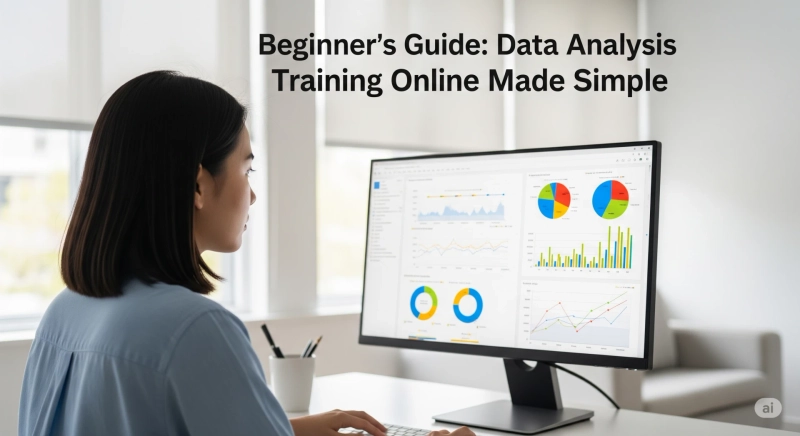Hey there! Are you feeling overwhelmed by the idea of diving into data analysis? Maybe you’ve heard it’s a game-changer for your career, but the thought of grappling with numbers, charts, and software makes you want to run for the hills.
Don’t worry you’re not alone. Many beginners feel stuck, unsure where to start or how to make sense of the vast world of data. The good news? Data analysis training online is more accessible than ever, and this blog is here to break it down for you in a simple, conversational way.
Whether you’re looking to boost your job prospects, make smarter decisions at work, or just understand what all the data fuss is about, this blog will walk you through the essentials and show you how to get started with confidence.
Why Data Analysis Matters for Beginners
Let’s start with the big picture. Data is everywhere—your favorite apps, your workplace, even your grocery store loyalty program. Companies use data to understand customers, improve products, and stay ahead of the competition. As a beginner, learning data analysis means you’re equipping yourself with a skill that’s in high demand across industries like marketing, finance, healthcare, and more.
But here’s the pain point: the world of data analysis can feel intimidating. Terms like “pivot tables,” “regression analysis,” or “Python” might sound like a foreign language. Maybe you’re worried you need to be a math genius or a coding expert to succeed. Spoiler alert: you don’t. Online data analysis training is designed to meet you where you are, breaking complex concepts into bite-sized pieces so you can learn at your own pace.
By learning data analysis, you’ll gain the ability to make sense of numbers, spot trends, and tell compelling stories with data. Imagine being the person who can walk into a meeting, present clear insights, and help your team make better decisions. That’s the power of data analysis—and it’s within your reach.
What Is Data Analysis, Anyway?
At its core, data analysis is about taking raw information—numbers, sales figures, customer feedback—and turning it into something meaningful. It’s like solving a puzzle: you collect the pieces (data), figure out how they fit together (analysis), and then share the picture (insights).
For beginners, the process typically involves:
- Collecting data: Gathering information from spreadsheets, databases, or even social media.
- Cleaning data: Fixing errors or inconsistencies to make the data reliable.
- Analyzing data: Using tools like Excel, Google Sheets, or Python to find patterns or trends.
- Visualizing data: Creating charts or graphs to make your findings easy to understand.
- Sharing insights: Explaining what the data means in a way that helps others make decisions.
Sounds like a lot, right? Don’t stress. Online training programs simplify each step, so you can focus on learning without feeling overwhelmed.
The Challenges Beginners Face (And How to Overcome Them)
Let’s address the elephant in the room: starting something new is hard. Here are some common pain points beginners face when learning data analysis—and how online training can help you tackle them:
1. “I’m Not a Math Person”
You don’t need to be a math whiz to excel at data analysis. Most online courses focus on practical skills, like using software to do the heavy lifting. Tools like Excel or Tableau handle the calculations for you, so you can focus on understanding the results. Start with beginner-friendly courses that emphasize real-world applications over complex formulas.
2. “I Don’t Have Time to Learn”
Busy schedule? Online training is flexible. You can learn at your own pace, whether it’s 30 minutes a day or a weekend deep-dive. Many platforms offer bite-sized lessons, so you can fit learning into your life without sacrificing your job or personal time.
3. “There Are Too Many Tools to Learn”
From Excel to Python to Power BI, the list of data analysis tools can feel endless. The solution? Start with one or two beginner-friendly tools. Most online courses guide you through the essentials, like Excel for spreadsheets or Google Data Studio for visualizations, before introducing more advanced options.
4. “I’m Afraid of Failing”
It’s normal to worry about getting stuck or not “getting” it. Good online training programs offer hands-on projects, quizzes, and community support to keep you on track. Plus, you can revisit lessons as many times as you need—no judgment, no pressure.
Choosing the Right Online Data Analysis Training
With so many courses out there, how do you pick the right one? Here’s what to look for to make sure you’re getting value for your time and money:
- Beginner-Friendly Content: Look for courses that assume no prior knowledge. They should start with the basics, like how to use spreadsheets or read charts.
- Hands-On Practice: Theory is great, but you need practice to build confidence. Choose programs with real-world projects or datasets to work on.
- Clear Instruction: The best courses use simple language and step-by-step guidance. Videos, quizzes, and downloadable resources can make learning more engaging.
- Certification: A certificate can boost your resume and show employers you’re serious about data analysis.
- Affordable Pricing: Many platforms offer free or low-cost courses to get you started, so you don’t have to break the bank.
Some popular platforms to consider include Coursera, Udemy, DataCamp, and LinkedIn Learning. Each offers beginner-level courses that cater to different learning styles.
Top Skills You’ll Learn in Data Analysis Training
Wondering what you’ll actually learn? Here’s a sneak peek at the key skills most online data analysis courses cover:
1. Working with Spreadsheets
Excel and Google Sheets are the bread and butter of data analysis. You’ll learn how to organize data, create formulas, and build pivot tables to summarize information quickly.
2. Data Visualization
Turning numbers into charts or graphs makes your insights pop. Tools like Tableau or Power BI help you create visuals that anyone can understand, even if they’re not data-savvy.
3. Basic Statistics
Don’t panic—this isn’t about memorizing formulas. You’ll learn simple concepts like averages, percentages, and trends to help you make sense of data.
4. Data Cleaning
Real-world data is messy. You’ll learn how to spot errors, remove duplicates, and prepare data for analysis.
5. Intro to Programming
Some courses introduce Python or R, programming languages that make data analysis faster and more powerful. Don’t worry—these are taught in a beginner-friendly way.
Why Monitoring and Evaluation Training Is a Game-Changer
If you’re interested in data analysis for social impact, development projects, or policy work, you might want to consider specialized training in Monitoring and Evaluation (M&E). M&E is all about using data to track progress, measure outcomes, and improve programs think of it as data analysis with a purpose. If this sounds like your thing, Sambodhi’s Certificate in Monitoring and Evaluation is a fantastic option to dive deeper.
This course equips you with practical skills to design, implement, and analyze M&E frameworks, making you a valuable asset in fields like public health, education, or international development. With expert-led instruction and real-world projects, you’ll gain the confidence to turn data into actionable insights that drive change. Ready to take the next step? Join Sambodhi’s certification program today and start making a difference with data!
Tips to Stay Motivated While Learning
Learning data analysis is exciting, but it’s normal to hit a few roadblocks. Here are some tips to keep you going:
- Set Small Goals: Instead of aiming to “master data analysis,” focus on smaller milestones, like completing one module or creating your first chart.
- Practice with Real Data: Use datasets that interest you, like sports stats or movie ratings, to make learning fun.
- Join a Community: Online forums or study groups can connect you with other learners for support and inspiration.
- Celebrate Wins: Finished a course module? Nailed a tricky formula? Give yourself a pat on the back!
How Data Analysis Can Transform Your Career
Once you’ve got the basics down, the possibilities are endless. Data analysis skills can open doors to roles like:
- Data Analyst: Help companies make decisions by analyzing sales, customer, or operational data.
- Business Analyst: Use data to solve business problems and improve efficiency.
- Marketing Analyst: Understand customer behavior to create better campaigns.
- Project Manager: Use data to track project progress and outcomes, especially in M&E roles.
Even if you’re not aiming for a data-specific job, these skills make you stand out. You’ll be the person who can back up ideas with facts, impressing bosses and colleagues alike.
Getting Started Today
Ready to jump in? Here’s your action plan:
- Pick a Course: Start with a beginner-friendly option on platforms like Coursera or DataCamp.
- Set Aside Time: Even 20 minutes a day can add up to big progress.
- Start Small: Focus on one tool, like Excel, before branching out.
- Practice, Practice, Practice: Apply what you learn to real-world data for maximum impact.
- Consider M&E Training: If you’re passionate about social impact, check out Sambodhi’s certification program for specialized skills.
Data analysis doesn’t have to be scary. With the right online training, you’ll go from feeling overwhelmed to confidently turning data into insights. So, what are you waiting for? Take that first step today, and soon you’ll be the one making sense of the numbers—and loving every minute of it!



